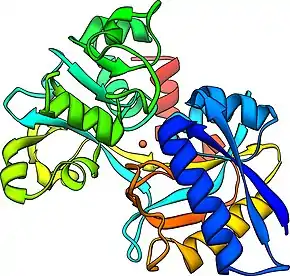Total iron-binding capacity
Total iron-binding capacity (TIBC) or sometimes transferrin iron-binding capacity is a medical laboratory test that measures the blood's capacity to bind iron with transferrin.[1] Transferrin can bind two atoms of ferric iron (Fe3+) with high affinity. It means that transferrin has the capacity to transport approximately from 1.40 to 1.49 mg of iron per gram of transferrin present in the blood.[2]
| Total iron-binding capacity | |
|---|---|
 The transferrin protein binds free iron and transports it in the blood. | |
| Synonyms | Transferrin iron-binding capacity |
| MedlinePlus | 003489 |
| LOINC | 2500-7, 14800-7, 35215-3 |
It is performed by drawing blood and measuring the maximum amount of iron that it can carry, which indirectly measures transferrin[3] since transferrin is the most dynamic carrier. If TIBC values are known, the transferrin concentration can be estimated with the following formulas:[2]
- Transferrin (mg/dL) = 0.8 x TIBC (µg of iron/dL) – 43
- Transferrin (mg/dL) = 0.7 x TIBC (µg of iron/dL)
To measure TIBC in the blood is less expensive than a direct measurement of transferrin.[4][5]
The TIBC should not be confused with the unsaturated iron-binding capacity or UIBC (LOINC 2501-5, 22753-8 & 35216-1). The UIBC is calculated by subtracting the serum iron from the TIBC.[6]
Interpretation
Taken together with serum iron and percent transferrin saturation clinicians usually perform this test when they are concerned about anemia, iron deficiency or iron deficiency anemia. However, because the liver produces transferrin, alterations in function (such as cirrhosis, hepatitis, or liver failure) must be considered when performing this test. It can also be an indirect test of liver function, but is rarely used for this purpose.[7]
The percent transferrin saturation (i.e., the result of the formula of serum iron/TIBC x 100) can also be a useful indicator. Studies also revealed that a transferrin saturation (serum iron concentration ÷ total iron binding capacity) over 60 percent in men and over 50 percent in women identified the presence of an abnormality in iron metabolism (hereditary hemochromatosis, heterozygotes and homozygotes) with approximately 95 percent accuracy. This finding helps in the early diagnosis of hereditary hemochromatosis, especially while serum ferritin still remains low. The retained iron in hereditary hemochromatosis is primarily deposited in parenchymal cells, with reticuloendothelial cell accumulation occurring very late in the disease. This is in contrast to transfusional iron overload in which iron deposition occurs first in the reticuloendothelial cells and then in parenchymal cells. This explains why ferritin levels remain relative low in hereditary hemochromatosis, while transferrin saturation is high.[8][9]
| Condition | Serum iron (highly variable) | Transferrin and TIBC | Percent transferrin saturation |
|---|---|---|---|
| Iron deficiency anemia | Low | High. The liver produces more transferrin, presumably attempting to maximize use of the little iron that is available. | Low, as there is insufficient iron. |
| Anemia of chronic disease | Low, as the body holds iron intracellularly with ferritin. | Low. The body produces less transferrin (but more ferritin), presumably to keep iron away from pathogens that require it for their metabolism. This is mainly regulated by increased hepcidin production. | Normal |
| Pregnancy or use of hormonal contraception, but without iron deficiency | Normal | High. The liver increases the production of transferrin, thus raising TIBC. | Low, as there is excess transferrin with normal serum iron levels. |
These examples demonstrate that to properly understand a value for TIBC, one also must know the serum iron, the percent transferrin saturation, and the individual clinical situation. In modern laboratory testings, serum ferritin levels are generally accepted as reliable single indicators of the presence of iron deficiency.
Usual values

Laboratories often use different units of measurement and "normal ranges" may vary by population and the laboratory techniques used. Look at the individual laboratory reference values to interpret a specific test (for instance, your own). Example reference ranges are:
- Serum iron: Male 65–177 μg/dL (11.6–31.7 μmol/L); Female 50–170 μg/dL (9.0–30.4 μmol/L)
- TIBC: 250–370 μg/dL (45-66 μmol/L)[10]
- Transferrin saturation: Male 20–50%; Female 15–50%
- Serum ferritin: Male 20-250 μg/L, Female 15-150 μg/L[10]
μg/dL = micrograms per deciliter; μmol/L = micromoles per litre.
References
- "MedlinePlus Medical Encyclopedia: Total iron binding capacity". Retrieved 2008-12-31.
- "MrLabTest: Normal TIBC level in the blood". Retrieved 2020-11-19.
- Yamanishi H, Iyama S, Yamaguchi Y, Kanakura Y, Iwatani Y (January 2003). "Total iron-binding capacity calculated from serum transferrin concentration or serum iron concentration and unsaturated iron-binding capacity". Clin. Chem. 49 (1): 175–8. doi:10.1373/49.1.175. PMID 12507977.
- Kasvosve I, Delanghe J (October 2002). "Total iron binding capacity and transferrin concentration in the assessment of iron status". Clin. Chem. Lab. Med. 40 (10): 1014–8. doi:10.1515/CCLM.2002.176. PMID 12476940. S2CID 45447911.
- Gambino R, Desvarieux E, Orth M, et al. (December 1997). "The relation between chemically measured total iron-binding capacity concentrations and immunologically measured transferrin concentrations in human serum". Clin. Chem. 43 (12): 2408–12. doi:10.1093/clinchem/43.12.2408. PMID 9439462.
- "Iron Transport". Retrieved 2008-12-31.
- Khare S, Garg VK, Jatav O. "Serum Iron and TIBC Parameters in Chronic Liver Disease" (PDF). Retrieved 2020-11-19.
- https://aasld2014.uberflip.com/i/581653/0
- "Hemochromatosis - AASLD Hemochromatosis".
- Harrison's Principles of Internal Medicine. 17th Edition (2008). Pg. 2432 (Table 351-2)
External links
- TIBC, UIBC and Transferrin Saturation at Lab Tests Online